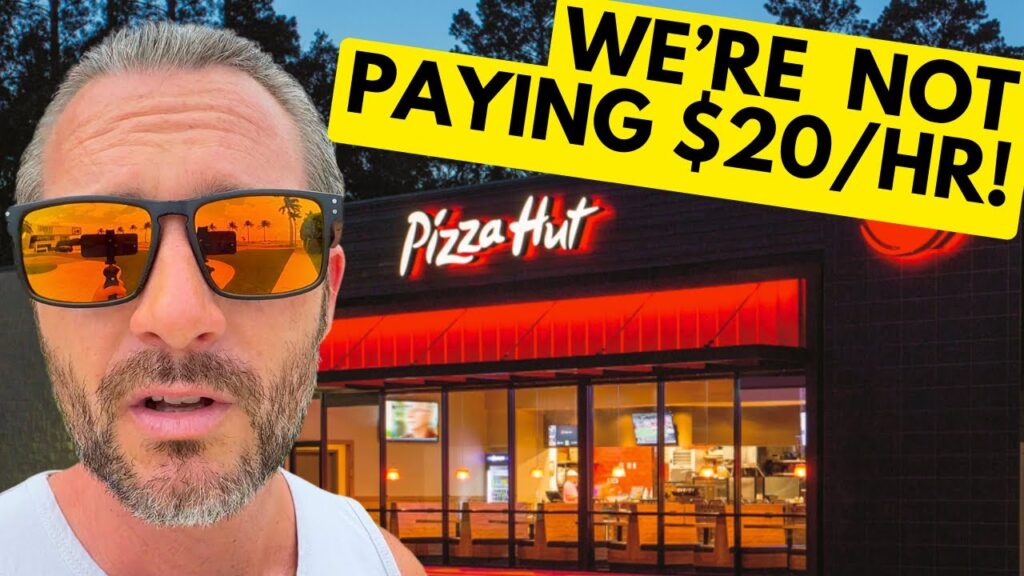FAST FOOD LAYOFFS ARE HERE! THOUSANDS LOSING THEIR JOB…
Hey there! Are you aware of the recent fast food layoffs happening in California due to the upcoming $20 per hour minimum wage for fast food workers? Thousands of workers are being let go or having their hours reduced by business owners to manage labor costs. This has potential economic implications, especially if the $20 per hour minimum wage becomes national. You can stay updated on this issue with Michael Bordenaro’s 1 on 1 calls and weekly video updates through email sign-up. Affiliate links may be present in his video descriptions, offering commissions on purchases made through the links. Keep in mind that the video content is for informational, educational, and entertainment purposes only, and Michael Bordenaro is not a registered financial advisor.
The fast food layoffs are a real concern as business owners in California are already finding ways to avoid paying the increased minimum wage by laying off employees and automating processes. This could lead to longer wait times and poorer service for customers due to understaffing in restaurants. With the potential national increase in minimum wage, other businesses may also face pressure to raise wages or cut costs, impacting the overall job market. It’ll be interesting to see how this situation unfolds, especially with the possible implications for entrepreneurs looking to open new businesses amidst these changes in the labor market.
Overview of Fast Food Layoffs
As fast-food layoffs continue to rise in California, the focus shifts to the impact of the new $20 per hour minimum wage for fast-food workers. The implications of these layoffs extend beyond individual workers to the broader economy and the fast-food industry as a whole. Additionally, there is speculation about how these changes in California may influence potential future national minimum wage policies.
Introduction to the issue of fast food layoffs in California
The issue of fast-food layoffs in California has gained significant attention due to the impending increase in the minimum wage to $20 per hour. Business owners are making strategic decisions to navigate these changes, which are resulting in job losses and reduced working hours for many fast-food workers.
Reasons for the layoffs such as the new $20 per hour minimum wage
One of the primary reasons for the fast-food layoffs in California is the implementation of the new $20 per hour minimum wage. This wage hike has prompted business owners to reevaluate their labor costs and make adjustments to remain financially viable in a competitive market.
Anticipation of economic implications if $20 per hour becomes the national minimum wage
The potential economic implications of the $20 per hour minimum wage becoming a nationwide standard are significant. It raises questions about the sustainability of small businesses, job availability, consumer prices, and overall economic stability. Understanding these implications is essential for forecasting the future of the fast-food industry.
Impact on Fast Food Workers
With thousands of fast-food workers facing layoffs or reduced working hours, it’s important to recognize the challenges they are encountering and the potential long-term effects on both individual workers and the fast-food industry as a whole.
Thousands of workers being laid off or having hours reduced
The direct impact of fast-food layoffs is evident in the thousands of workers who are experiencing job loss or reduced hours. This sudden shift in employment status can have profound effects on individuals and their families, leading to financial strain and uncertainty.
Challenges faced by workers due to the layoffs
Workers who are affected by the layoffs are facing challenges such as finding new employment opportunities, coping with reduced income, and navigating potential changes to their standard of living. These challenges can be particularly daunting in a competitive job market, especially for those with limited skills or experience.
Potential long-term effects on the fast-food industry
The long-term effects of the layoffs within the fast-food industry are multifaceted. From changes in workforce dynamics to shifts in consumer demand, the industry may undergo substantial transformations as business owners adapt to new labor cost structures. Understanding these potential effects is crucial for stakeholders within the industry.

Strategies Employed by Business Owners
Business owners in California are implementing various strategies to mitigate the impact of the $20 per hour minimum wage, including reducing staff and automating processes to cut labor costs. While these strategies may offer short-term solutions, they also present potential consequences that need to be considered.
Ways business owners in California are trying to avoid paying $20 per hour
To avoid the burden of paying $20 per hour, business owners are exploring alternative measures such as reducing staff, adjusting operating hours, or introducing automation technologies. These tactics aim to streamline operations and maintain profitability in the face of increasing labor costs.
Laying off employees and automating processes to cut labor costs
Laying off employees and automated processes are common strategies employed by business owners to reduce labor costs. While these actions may initially result in cost savings, they could lead to long-term implications such as decreased workforce morale, diminished customer service quality, and potential backlash from the community.
Potential consequences of these strategies
It is important to consider the potential consequences of laying off employees and automating processes as cost-cutting measures. These decisions may impact employee job security, customer satisfaction, and overall business sustainability. Business owners must weigh these consequences against short-term gains to ensure the long-term viability of their establishments.
National Implications
The discussion surrounding the $20 per hour minimum wage in California has broader implications that extend beyond state borders. Anticipation of the wage increase becoming nationwide raises questions about how other states may react and how industries could be affected on a national scale.
Possibility of $20 per hour minimum wage extending nationwide
The potential extension of the $20 per hour minimum wage to other states could significantly impact various industries across the country. Understanding the implications of such a wage increase is essential for policymakers, businesses, and workers preparing for potential changes in labor practices.
How other states may react to the California minimum wage increase
The California minimum wage increase serves as a litmus test for how other states may respond to similar wage hikes. Observing how businesses and policymakers in other states react to these changes can provide valuable insights into the future of labor regulations and minimum wage standards.
Discussion on the impact of national minimum wage increase on industries
A national minimum wage increase to $20 per hour would have far-reaching effects on industries nationwide. From small businesses to large corporations, understanding the impact of such a policy shift is crucial for strategic planning, workforce management, and economic forecasting.

Response from Michael Bordenaro
In response to the fast-food layoffs and $20 per hour minimum wage discussions, Michael Bordenaro has offered resources, including 1 on 1 calls and weekly video updates through email list sign-ups. While these offerings provide valuable information, it is important to consider the nature of the content and any potential affiliate links within the videos.
Offering 1 on 1 calls and weekly video updates through Email list sign up
Michael Bordenaro’s response to the fast-food layoffs includes personalized calls and regular video updates accessible through email sign-ups. These resources aim to provide insights, guidance, and updates on relevant topics related to labor cost management, industry trends, and economic implications.
Presence of affiliate links in video descriptions for commission
As part of his content creation, Michael Bordenaro may include affiliate links in the descriptions of his videos. These links offer viewers the opportunity to support the channel through commissions on purchases made through the links. Understanding the presence of affiliate links is essential when engaging with the video content.
Disclaimer on the nature of video content and advice provided
To ensure transparency and clarity, it is crucial to recognize the disclaimer provided by Michael Bordenaro regarding the informational, educational, and entertainment nature of his video content. Viewers should be aware that Michael Bordenaro is not a registered financial advisor, and the content showcased should be consumed with this disclaimer in mind.
Adaptation by Fast Food Restaurants
As fast-food restaurants adapt to the changing labor landscape in California, business owners are implementing strategies such as reducing staff and raising prices to cover labor costs. These adaptations may impact the customer experience and overall operational efficiency within the industry.
Business owners reducing staff and increasing prices to cover labor costs
In response to the $20 per hour minimum wage, business owners are reducing staff and raising prices to offset increased labor costs. These adjustments directly impact the customer experience by potentially leading to longer wait times, reduced service quality, and higher overall costs for consumers.
Implementation of automation processes in restaurants
To streamline operations and reduce labor costs, fast-food restaurants are increasingly turning to automation processes. From food preparation to customer service, automation technologies are being integrated to enhance efficiency while minimizing the reliance on manual labor.
Effects on customer experience due to changes in staffing levels
The changes in staffing levels and operational processes within fast-food restaurants may have direct implications on the customer experience. Longer wait times, understaffed establishments, and potential service quality issues could impact consumer satisfaction and loyalty in the long run.

Future Outlook
Predicting the future of the fast-food industry in California and beyond requires an analysis of industry-wide changes, minimum wage implications, and opportunities for both workers and businesses. Balancing the needs of all stakeholders is essential for navigating the evolving landscape of labor cost management.
Predictions on the future of fast food industry in California
Moving forward, the fast-food industry in California is likely to undergo significant transformations as businesses adapt to new labor cost structures and consumer demands. Predictions on employment trends, operational efficiency, and market competitiveness can offer insights into the future outlook for the industry.
Discussion on the possibility of industry-wide changes due to minimum wage increase
The minimum wage increase in California has the potential to trigger industry-wide changes that extend beyond fast-food establishments. From shifts in consumer behavior to alterations in business models, understanding the broader implications of the wage increase is crucial for preparing for future challenges and opportunities.
Challenges and opportunities for workers and businesses in the fast-food sector
Navigating the challenges and opportunities presented by the fast-food industry’s changing landscape requires a comprehensive approach that prioritizes the needs of workers and businesses alike. Addressing issues such as job security, wage sustainability, and industry competitiveness can help stakeholders prepare for the future.
Conclusion
In conclusion, the impact of fast food layoffs in California is a complex issue that necessitates a balanced approach to labor cost management. Recognizing the challenges faced by workers, the strategies employed by business owners, and the potential national implications of wage increases is essential for fostering a resilient and sustainable industry. It is crucial to consider the needs of all stakeholders, from employees to consumers, when addressing labor cost challenges and wage policy changes within the fast-food sector.


